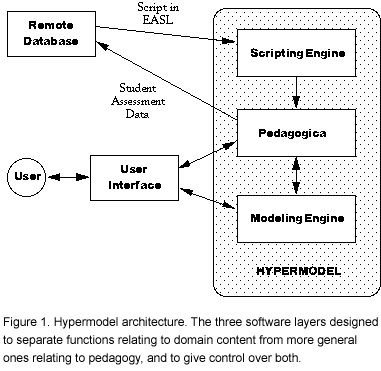Hypermodel
Jump to navigation
Jump to search
Definition
- Hypermodel probably refers to a lot things...
- In educational technology, hypermodel has probably been coined by Robert Tinker and refers to a sort of pedagogically structured microworld and a model-based learning design.
- The "hypermodel," a new type of learning technology that blends aspects of models, simulations, and hypermedia. [1]
The instructional design model and the systems architecture
- We should this topic to some other page some day, below just a series of quotes for starters - DSchneider 16:21, 21 July 2006 (MEST)
- “Hypermodels integrate stored information in the form of multimedia materials, experimental data, and text, with a manipulable model of the subject domain. Just as hypertext enables one to navigate through textual materials by clicking on individual words and phrases, with hypermodels students navigate through a learning activity by manipulating a computer-based model. The activity typically presents a more or less open-ended challenge (e.g., "Breed these organisms as efficiently as possible, trying to get all the offspring to look like this.") and then leaves the students alone and monitors them (Which organisms do they choose to breed? How do they react to the outcome?) as they try to accomplish the goal.” [2].
- “Hypermodels share some characteristics with CAI (computer assisted instruction) applications, which also control what the learner sees, evaluate progress, and, if they are "intelligent," can adapt to student responses and learning styles. The critical difference is that hypermodels have at their core a sophisticated tool that students can use to learn content through exploration and inquiry; a constructivist educational strategy. In contrast, CAI software is usually much more directive and "instructivist."” (Tinker: 2001).
- “Our underlying tools embody a pure constructivist philosophy that permits students to learn through open-ended exploration. Even though this type of learning is powerful, students can take too much time and miss important topics and the tool can be difficult to disseminate and confusing for beginners. Pedagogica converts the tool into a hypermodel that is somewhat instructivist, because the script constrains the tool and guides the learner to discover specific concepts that a curriculum developer has selected. Done well, students still learn through their own explorations, but within constrained domains and with guidance that ensures that most students discover the important concepts.”
Examples
- See systems built with Pedagogica (Tinker: 2001).
References
- Hickey, D. T., Kindfield, A. C. H., Horwitz, P., & Christie, M. A. Integrating curriculum, instruction, assessment, and evaluation in a technology-supported genetics environment. in American Educational Research Journal, 40 (2) 495-538. 2003
- Horwitz, Paul and Robert Tinker (2001), Pedagogica to the Rescue, A short history of hypermodels. @CONCORD: Volume 5, No. 1 HTML
- Horwitz, P. (1999). Turning information into knowledge: Hypermodel for science education: Final report submitted to National Science Foundation Education and Human Resources Directorate (Grant # RED-955343). Concord, MA: The Concord Consortium.
- Paul Horwitz, Linking Models to Data: Hypermodels for Science Education, [3]
- Tinker, Robert (2001), Perspective, Hypermodels: New Tools for Learning, @CONCORD: Volume 5, No. 1 HTML
